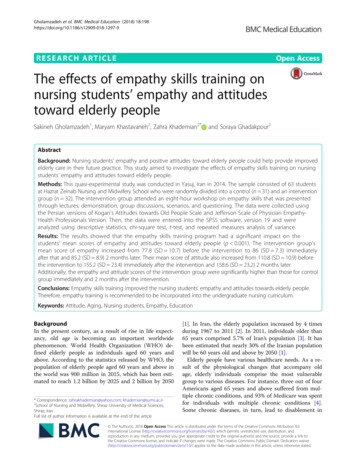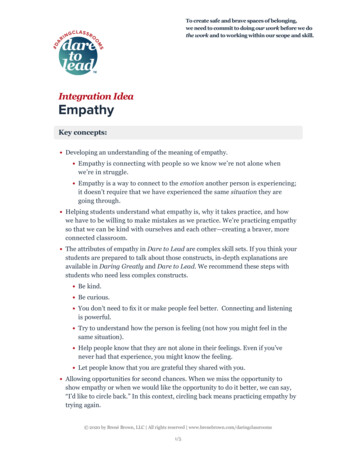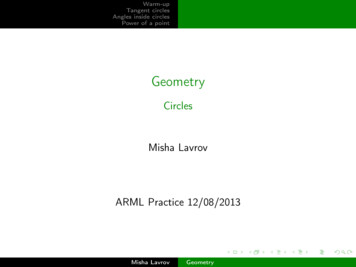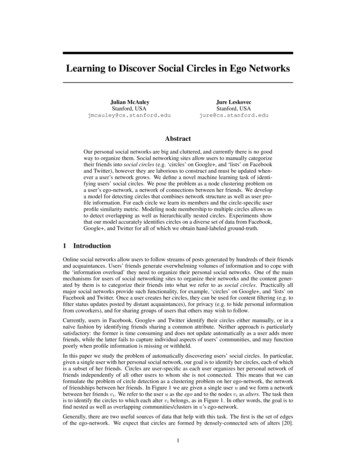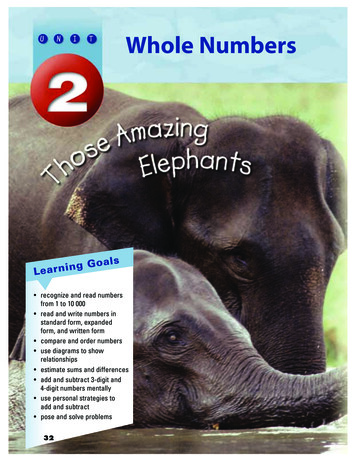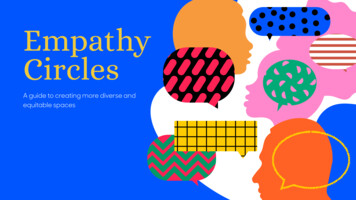
Transcription
EmpathyCirclesA guide to creating more diverse andequitable spaces
EmpathyCirclesBeyond theconversation1Define your purpose5Practice allyship2Choose your theme6Demand change3Set agreements4Listen and discuss
AUDRDEROLE“When we speak we areafraid our words will notbe heard nor welcomed,but when we are silent weare still afraid, so it isbetter to speak.”Writer, Feminist, Womanist, Librarian,and Civil Rights Activist
Empathy Circles areconversations on our livedexperiences. They’re exchanges ofpersonal stories, feelings, andideas on a theme: racial injustice,gender bias, or beyond.A launch pad for change, Empathy Circles are a small butmeaningful way to amplify conversations that matter. Insharing our experiences, we build compassion andunderstanding. We spotlight the issues impacting ourcommunities. And we pave the way for positive change.All Empathy Circles are grounded in honesty and nonjudgment. The listening and learning of uniqueexperiences may be affirming, restorative, disarming—even difficult. This means that everyone in the room mustfeel welcome, and everyone must commit to experiencingdiscomfort.Though we start with empathy, the exchange ofexperience is only a beginning. We need to continuallyreflect on biases and systems—thoughtfully, urgently, andin the long-term.
1NOITASEmpathy Circles are grounded in the ideathat conversation sparks understanding,and understanding sparks change.Here’s how.R S TA NEDDIUNNVOERCDefine your purposeNG
Make everyone heardInvite participants to shareexperiences, feelings, and ideas ina safe and non-judgmental space.This builds connection andreduces echo chambers withinorganizations.Water active empathyEmpathy goes beyond tokenism.By sharing and listening,participants develop compassionand meaningful curiosity, whichcan serve them long-term andbeyond professional life.Unite alliesOpen sharing is an entry point toallyship. When all participants areinvited to steer the conversation,we magnify lesser heard voices,and leaders become allies.Be accountableEmpathy Circles provide anavenue to continue the importantconversations. They build trustacross levels and help creategoals for more equitableoutcomes.Define your purpose
2Choose your themeTMEEHHost an Empathy Circle on any themeyou wish to shine a light on. You simplyneed a group of people, of any size,committed to coming together to talkabout what matters.OTO GEMETCIPKC AHER
Together, you could discussRacism and micro-aggressionsCultural complexitiesThe role of intersectionalityUnderstanding neurodiversityPolitical and historical injusticesLGBTQ Mental health and well-beingGender expressionAmplify the conversations that matter to your organization orcommunity. Build affinity and support. Create bridges forshared experiences, and grow understanding ofdiverging opinions.Choose your theme
3Set agreementsEmpathy Circles are built on trust. At thestart of every session, invite allparticipants to commit to sharedagreements. These can include:T R USTGARE EMTSNE
RespectConfidentialityDiscomfortEveryone will bring their uniqueperspectives. As a listener, beengaged. As a speaker, share yourtruth responsibly.Everything that’s said here,stays here.Get comfortable with discomfort.Be open to thinking differently.Set agreements
4Listen and discussFACILOTARSTIFirst, set the context. Participants will join with theirunique lens, so it’s helpful to create shared ground.We recommend a pair of facilitators open thediscussion with historical background or factualnews. They can share personal stories or motivationsto set the tone and create group trust.KGUN DCOARB
Next, open the discussion. Empathy Circles aretypically unstructured, with participants freelycontributing to the conversation. This happensorganically. Stories, feelings, and ideas shouldn’t bemediated, but facilitators can ensure that everyonehas the opportunity to participate.There is great power in open dialogue. As theenvironment is built on non-judgment, an agendafree conversation can flow with ease and respect.Though difficult feelings are guaranteed, empathyshould triumph. In this way, we open doors topowerful change.Listen and discuss
Beyond theconversationW O RD S
6ALPractice allyshipIPHSYLEmpathy Circles create allyship, butthey’re only part of a solution. In order tocreate meaningful change, allies mustcommit to lifelong work.
As an ally, I will1Listen to understand2Check my assumptions in order tounlearn biases3Speak up against inequitable commentsand actions4Take steps to make my workplaceequitable, safe, and welcoming5Advocate for historically marginalizedpeople to lead change, instead of assumingI know what’s helpful for themPractice allyship
7Demand changeAllyship must show up in every facet ofour lives. In collective ways,we make an impact.
Lead by exampleBe empatheticBe mindful of how you’re showing up—in your workplace,wider community, and with friends and family. Your dailylanguage and actions matter, as much as the publicmovements you’re turning up for.Create safe and welcoming spaces for difficult conversations.Be proactive about acknowledging impactful eventshappening in the world, and offer support.Use your sphere of influenceSeek out unconscious biasesCall out discrimination and inequities when you see them.Remember, silence is complicity.Wherever you have voice or power, leverage it. WIthin yourorganization, commit to a goal focused on diversity, inclusion,and equity—and recognize their valuable impact on business.Go beyond being supportive; give others a seat at the table.Advance equity, not equalityIf we treat everyone the same, injustice prevails. Equity isproviding support and advocacy relative to where it’s needed.Pay attention to the individual needs of those around you, andwork to dismantle systemic barriers.Demand change
In April 2020, Zendesk started hosting internalEmpathy Circles, as a response to theinequities amplified by COVID-19, and protestsagainst systemic racism. Our Empathy Circleshave been recognized by UC Berkeley’sCenter for Equity, Gender, and Leadership. Weencourage any organization or group to runtheir own Empathy Circles to catalyzeimportant conversations.This resource is made byZendesk. You’re welcometo spread it far and wide.GDEI@zendesk.com
and leaders become allies. Water active empathy Empathy goes beyond tokenism. By sharing and listening, participants develop compassion and meaningful curiosity, which can serve them long-term and beyond professional life. Be accountable Empathy Circles provide an avenue to continue the important conversations. They build trust

